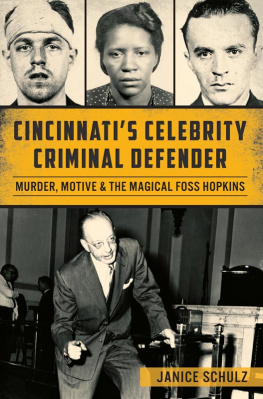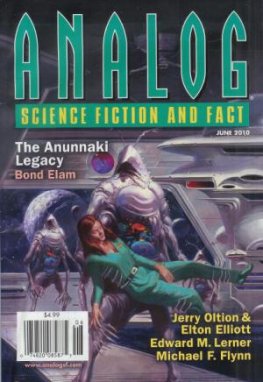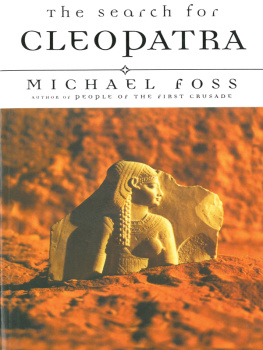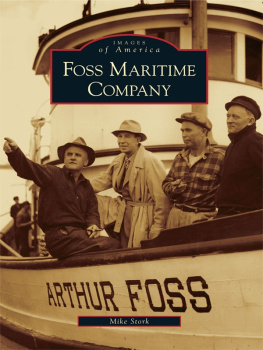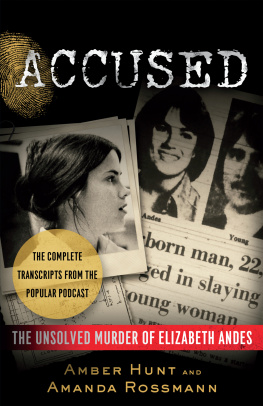


Published by The History Press
Charleston, SC 29403
www.historypress.net
Copyright 2015 by Janice Schulz
All rights reserved
Front cover: Wesley Belcher. Greater Cincinnati Police Historical Society Museum. Top middle: Betty Armstrong. Greater Cincinnati Police Historical Society Museum. Top right: William Kuhlman. Greater Cincinnati Police Historical Society Museum. Bottom: Foss in the courtroom. Greater Cincinnati Police Historical Society Museum.
All images courtesy of the Greater Cincinnati Police Historical Society Museum unless otherwise noted.
First published 2015
e-book edition 2015
ISBN 978.1.62585.480.3
Library of Congress Control Number: 2015945061
print edition ISBN 978.1.62619.943.9
Notice: The information in this book is true and complete to the best of our knowledge. It is offered without guarantee on the part of the author or The History Press. The author and The History Press disclaim all liability in connection with the use of this book.
All rights reserved. No part of this book may be reproduced or transmitted in any form whatsoever without prior written permission from the publisher except in the case of brief quotations embodied in critical articles and reviews.
To my husband, Kurt
PREFACE
William Foster Hopkins, better known simply as Foss, was a legendary Cincinnati criminal defense attorney who, in his fifty-five years of practice, struck a nerve in opposing counsel and delighted the media with his flamboyant, charismatic style. Foss commanded center stage on the legal scene for most of his career, from his establishment as William F. Hopkins, Attorney at Law in 1920 to the day in 1974 when the emphysema that would ultimately take his life forced him out of court in the middle of a case.
Fosss contribution to the legal history of Cincinnati has guaranteed he will never be completely out of the public eye. Since his death, articles have been written about him, and some of his cases have been highlighted in various books and media outlets. Additionally, he left us with a stunning autobiography, Murder Is My Business, in which he shares a personal vision on his life, career and cases. But autobiography is by nature one sided. In his own autobiography, Charles Darrow stated, Autobiography is never entirely true. No one can get the right perspective of himself. Every fact is colored by imagination and dream. That is one of the reasons I chose to write this book. Its time to get a more objective understanding of Foss.
Most of the cases I have chosen to feature in this book are taken from files in Fosss papers, housed in the Greater Cincinnati Police Historical Society Museum. Of the more than 550 clients he represented, only 34 of his files survive. We have those thanks to Dic Gross, curator at the museum, who saved them from an unknown fate when Fosss widow invited him to take whatever he could pack up and haul away. The extant collection contains the case files, as well as scrapbooks, news clippings, personal and professional papers and photographs, many of which appear in this book. I had the honor of being allowed to process the collection when it was acquired, which fueled my interest in studying Foss and his career. Along with the papers, the museum houses Fosss collection of weapons used in some of his cases. Youll see photos of some of those in this book. Foss intended to include photos in Murder Is My Businesscaptions attached to some of the photos in his papers indicate thatbut for reasons unknown, they never made it to the book. Ive put many of those photos in my book.
Considering Fosss extensive career, it would be impossible to include all or even most of his work in just one book. Several of his cases deserve entire volumes of their own. It may surprise some people that I chose to exclude some of his more closely followed cases, but I feel there are elements of some of the lesser-known cases that show a side of Foss that deserves to be explored. They also demonstrate, perhaps, one of the reasons true crime is so popular. The sensationalized accounts of crime, especially murders, certainly draw us in, but I believe the real reason we continue coming back is a bit more personal. Most of those criminals are, in essence, just like you and me. As Foss said in Murder Is My Business, For most of them, life had been ordinary until they got involved one timeand one time onlywith murder.
ACKNOWLEDGEMENTS
Many thanks to the following who helped make this dream a reality:
The gentlemen at the Greater Cincinnati Police Historical Society Museum, who always went out of their way to make material available to me and who always made me feel welcome and wanted. A special thanks goes to Steve Kramer and Dic Gross.
My friend and mentor Kevin Grace, who encouraged me to explore Foss as a feature subject and who gave me every opportunity to research, write and develop my skills as an author.
My wonderful husband, Kurt Schulz, who was my scanner, photographer and all-around image guru. Thank you for following me around to archives, libraries and museums for the past sixteen years.
My dad, Rich Leskovac, whose career as a police officer was my inspiration for studying law enforcement, crime and punishment.
My team of reviewersKurt Schulz, Donna Leskovac, Diana Mallory and Liselle Konig.
My commissioning editor at The History Press, Krista Slavicek, whose guidance, advice and patient answers to my endless questions kept me on task and got me through this process.
FOUNDATIONS
Criminal defense attorneys are not high on the universal list of lovable creatures. They stand on the side of some of the worst individuals society has to offer and seemingly argue against its helpless victims. Accordingly, they can be perceived as heartless, even immoral, and attempts to humanize them can fall on deaf ears.
Foss was not immune to this stigma. Even while he was described as charismatic, brilliant and talented, during his career, he was cursed at, threatened, insulted and received more than his share of dirty looks because of the job he chose to pursue. To some, his outward appearance was one of a hardnosed, thick-skinned defender of the damned. Given this impression, it may be difficult to picture him in a modest, loving, stable and supportive environment, but that is exactly the kind of background that produced Cincinnatis most famous and controversial criminal defense attorney.
In fact, Foss was the product of several pioneering southern Ohio families who gave him a solid foundation in life. His ancestors were hardworking, respected people who contributed a great deal to their communities and bequeathed to him a love of family, a strong work ethic and a dedication to service. Foss inherited resourcefulness and tenacity from his family; these vital characteristics served him well in his career.
The first Hopkins family emigrated from Kentucky to Ohio in 1804, just a year after Ohio officially became a state, and settled in Warren Countys south central Hamilton Township, near present-day Maineville. The area had earlier been settled through Revolutionary land warrants issued by the government to individuals for service rendered during the war. The village that became known as Hopkinsville, after the family that settled near it, was founded around 1808. For a time, it was an important place of trade, an election center and a public gathering place. Ohios original Hopkins settlers consisted of widower James Hopkins and his sons, John and James, who were natives of Virginia before a nine-year stay in Kentucky. Their mother, Margaret, died in Kentucky before the move. All accounts stress that the Hopkins boys were well educated before they arrived in Ohio and that education was important to the family.
Next page
